
- Markets
- Solutions
- Services
- Innovations
- Resources
- About Us
- Careers
- Contact Us
August 14, 2014
In their landmark paper published in 20001, Gupta and Kumar laid out, in very simple terms, something known to network planners and engineering professionals for some time; that the capacity of wireless networks is (measured in load per sq. km. per Mhz of allocated spectrum) is primarily limited by interference. A large library of literature has since extended their basic findings to relay networks2, ad-hoc networks3, mesh networks4 and various other specialized cases. In recent years, this remarkable result has been repeatedly verified empirically for successive generations of new technologies deployed in the field; starting from soft and softer handovers in WCDMA, to inter-cell spectrum sharing for OFDM based networks.
The most recent of these technologies is LTE. Indeed, LTE was designed from the beginning with inter-cell interference in mind (based mostly on past experience of the designers in WCDMA networks). However, with the arrival of small-cell and heterogeneous networks (HetNets), the existing mechanisms are quickly approaching the interference limits predicted by Gupta and Kumar.
In this post, we will examine the most current developments of the technologies and standards specifically introduced in the latest research that deals with interference in the case of heterogeneous networks. As new network topologies are being introduced, new forms of interference are appearing as well. Thus, new acronyms like ICIC (for Inter Cell Interference Coordination) and eICICI (extended Inter Cell Interference Coordination) have been created specifically to describe mechanisms used in dealing with these new scenarios. In keeping with the modern trend of cooperative networking, ICIC (or eICIC) puts strong emphasis on dynamic, inter-cell communication and coordination as opposed to the earlier emphasis on static network planning. As you’ll see in the sections below, this change leads to interesting new challenges in network design and capacity management.
LTE uses OFDMA in downlink and SCFDMA in uplink. The inherent orthogonality of these transmission schemes reduces the intracell interference. However, the issue of intercell interference has been a constant topic of discussion in evolving LTE standards5.
The problem of intercell interference impacts the UEs at cell edges because as the frequency is reused across the cells, the edge UEs may be allocated the same subcarriers. As these UEs operate on high power to reach the eNBs, the signals interfere strongly. The edge UEs receive equally strong/weak signals from the adjacent cells, and so the strong interference causes difficulty for the UE when receiving downlink transmission.
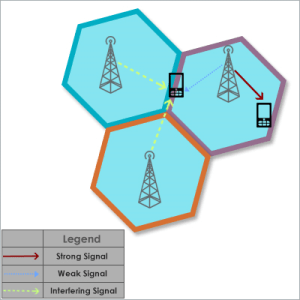
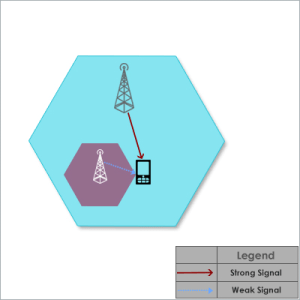
The interference problem gets even more complicated in small cells, wherein the small cell overlaps the macro cell6. As the small cell eNBs operate at a lower power level, the problem extends to ensuring that a UE actually attaches to small cell eNB in proximity, rather that attaching to a macro eNB operating at high power. In this case, the cell edge is the point where the UE receives similar strength signals from both the macro and small cell.
Inter Macro-Small Cell Interference
But that’s only part of the problem. When the small cells are exclusively deployed for closed group subscribers (CSG), the interference solutions become further complicated.
Various solutions have been suggested 5,7,8,9 for dealing with interference issue amongst cells:
Fractional Frequency Reuse
Frequency is split into two parts: cell center frequency and cell edge frequency. The cell edge frequency assignment is non-overlapping for adjacent cells. This reduces the interference at the edge, at the cost of frequency reuse factor for the cell.
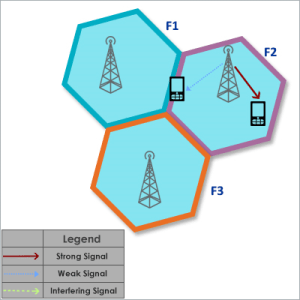
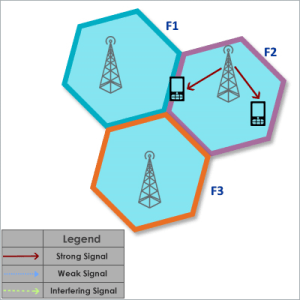
Non-Overlapping Frequency Allocation At Edges
Selective Power Reuse
In this scheme, adjacent cells use lower power for the cell center users, and higher power for the edge users. The eNBs exchange RNTP(relative narrowband transmit power)messages over X2 interface to indicate the time and frequency for which the power will be transmitted higher for the cell edge users.
High Power Signal At Cell Edge
Cell Range Extension
To ensure that the UEs close to small cell eNB do not attach with the macro eNB instead, a positive cell selection offset is added to the small cells. This increases the effective coverage of the small cell.
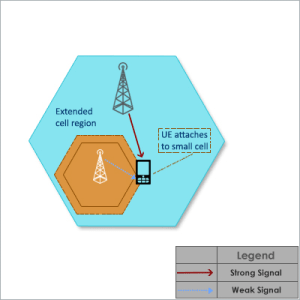
Cell Range Extended, UE Will Attach To Small Cell
Interference & Overload Indication
In this approach, high interference indicator (HII), a bitmap, indicates scheduling of cell edge UEs. This message is exchanged between neighboring eNBs. The eNBs can thus coordinate their scheduling decisions and avoid interference for cell edge UEs.
Additionally, an overload indicator (OI) indicates when cell edge UEs experience high interference. The receiving eNB is then able to adjust power and reduce interference.
Extended ICIC (eICIC)
The eICIC scheme focuses on the time domain solution to the interference problem, referred to as ABS, or Almost Blank Subframes 10.
Here, the interfering eNB leaves some specified subframes as “almost blank” so that the victim eNB can transmit to the UE without facing a strong interfering signal. The eNBs exchange X2 messages in order to learn of the AB subframes in advance. The interfering eNB transmits minimal information in these subframes; only the data which is mandatory to transmit for supporting the legacy UEs. This information consists mainly of synchronization signals, reference signals, UE scheduling, and HARQ related information.
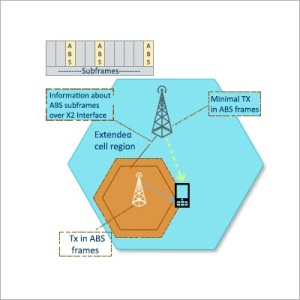
Transmission By Small Cell In ABS Subframe
Further Extended ICIC (feICIC)
The ABS solution minimizes the intercell interference a great deal, barring the CRS and selected control channel information. Multiple options for dealing with this are considered 11 in the study of feICIC, 3GPP and various research initiatives. Some of these are:
Future Trends in ICIC
The mechanisms described above are mostly intended to help with interference reduction. In future developments, we should expect to see more active techniques for combatting interference added to the arsenal. In these, different eNodeBs will coordinate with each other to jointly transmit signals to one or more receivers directly; this will also be replicated in the uplink.
Coordinated multipoint transmission or COMP is currently a part of the LTE specification, but it is mostly focused on increasing throughput to individual users, rather than ICIC12. However, the same techniques, with some changes in signaling can be used for interference coordination, especially in the HetNet case, where there is a large overlap between macro and small-cell coverage.
Check back soon, as in an upcoming post, we’ll outline the application of COMP in this domain, and our own research for the same.